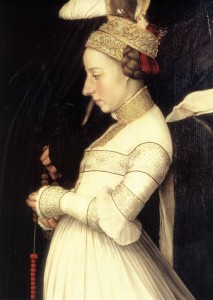Blackwork embroidery was prevalent during 16th century Western Europe, including Germany (where it was known as Schwarzstickerei). Unfortunately, most of the extant embroidered items, books, and online resources are heavy on the English blackwork styles. So what’s one to do if you want to embroider blackwork that would be appropriate to renaissance Germany? Well, we can thank Johannes Gutenberg, who started the Printing Revolution right in Germany! We have at least three reliable German embroidery pattern books (Modelbücher) with counted blackwork patterns to work from, meaning we can go right to the source when we want German blackwork patterns. And two of these modelbooks are online, too!
German Blackwork Pattern Books:
Hoefer, Hans. Formbèuchlein. 1545, Augsburg (pages 78-82, 84) – Sample Page PDF – Digital Edition available from the HathiTrust Digital Library.
Gilbers, Georg. Modelbuch aller art Nehewercks und Stickens. Reprint of 1527 book. (many of these patterns could be adapted to blackwork, though only a few are clearly linear).
Bassée, Nicolas, New Modelbuch of 1568. Located in the rare book collection on the Newberry Library in Chicago, Illinois, USA. (Alas, I have yet to find this book online, but you can see charted patterns from this book by Claudette Ziemann at 16th c. German Blackwork Patterns / PDF) – A copy of this book was published in 1994 by Curious Works Press (ISBN 0-9633331-4-3).
I want to note, however, that modelbooks like this often borrowed/purchased woodcuts from one another and other books, making things a bit confusing at time. For example, the Hans Hoefer Formbeuchlein noted above was reprinted in 1913 as Zwickauer Facsimiledrucke No. 23 and appears to have different woodcut charts than the version I’ve linked above. I am going to hunt down more copies of these books so I can compare them better!
In the meantime, I have identified a pattern that comes from both Hoefer and Bassee that I’d very much like to try in the future:



Dear Genoveva,
What would you say are the top say half a dozen embroidery stiches used in southern Germany during the renassiance, besides the blackwork that is?
I started work on a sleeve and now I am wondering if I am doing it with modern stiches instead of period ones.
I have been useing a simple satin stich mostly.
I have looked high and low on the internet and at my local library. But there is so little that I can find. Most is in german, with no pictures. Go figure huh. LOL
This is why I like to do steampunk for friends. Not so much research. And there are fewer costume police than the SCA. LOL
I don’t want to put a lot of work into my Swabian a symentry dress, just to have it destroyed at A&S.
I hope you have some conections. I don’t need alot of stiches, as I want to bead the thing too.
Thanks, Cate
Based on my research, these embroidery stitches were common during Renaissance Germany: cross stitch, satin stitch, running stitch, split stitch, back stitch, double running stitch (blackwork), and couching. However, you mentioned that you’re making a Swabian-style dress? My understanding of those is that they are mostly applique, with goldwork, beading and spangles. See http://www.gluckliche-eme.com/perlensticken.htm and http://medievalhandwork.com/tag/swabian/ . Hope this helps!
Thank you so much!!! I am safe YEAH. I got a book from the library, one of those oversised goodies. It has a large picture of the lady with the “Golden Fleese” around her neck and the huge brain bag on her head LOL
. I can clearly see Beading, applique, and embroidery. The embroidrey look to be straight stich running stich or back stich and couching. But I wasn’t really sure.The embroider is out linning applique, beading etc. it also is used to fill in small objects like flowers. But from what I can se it’s simple stiches. Thanks for confirming what I have been able to garner on this!
I have truly enjoyed your site! Here are some other Modelbuchs I have found while researching that I’d like to share with you to say thank you… there are links to jpegs of each page ofn the Modelbuchs listed below
http://jillwheezul.livejournal.com/245929.html?thread=1264041
***Ein new Modelbuch auff außnehen vnd borten wircken … Anno Domini 1526
Johann Schönsperger (der Jüngere), 1526, Berlin, Staatliche Museen zu Berlin – Preußischer Kulturbesitz, Kunstbibliothek —
***Eyn Neu furmbüchlein
Ein ney Furmbüchlein.
Johann Schönsperger (der Jüngere), Berlin, Staatliche Museen zu Berlin – Preußischer Kulturbesitz, Kunstbibliothek, Inv.-Nr. OS 25.193 —
***F(urm oder modelbüchlein. Augsburg zwischen 1527 und 1529), 2 Bände
Johann Schönsperger (der Jüngere) Drucker
faktischer Entstehungsort: Augsburg, 1527-1529
Folge (gebunden), Seriendruck, Reproduktionsgraphik
***Ein new getruckt model Büchli auff außnehen, vnnd bortten wircken …
Johann Schönsperger (der Jüngere) Drucker
1529
Titel und 45 Seiten
(Katalog OS, 1939)